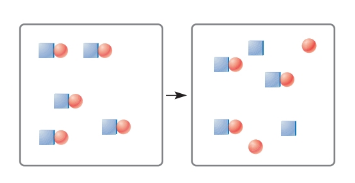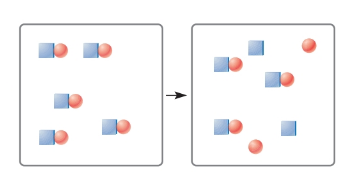![OWLv2 for Masterton/Hurley's Chemistry: Principles and Reactions, 8th Edition, [Instant Access], 1 term (6 months)](https://s3.amazonaws.com/compass-isbn-assets/textbook_empty_images/large_textbook_empty.svg)
OWLv2 for Masterton/Hurley's Chemistry: Principles and Reactions, 8th Edition, [Instant Access], 1 term (6 months)
8th Edition
ISBN: 9781305079311
Author: William L. Masterton; Cecile N. Hurley
Publisher: Cengage Learning US
expand_more
expand_more
format_list_bulleted
Concept explainers
Textbook Question
Chapter 4, Problem 68QAP
The following figures represent species before and after they are dissolved in water. Classify each species as weak electrolyte, strong electrolyte, or nonelectrolyte. You may assume that species that dissociate during solution break up as ions.


Expert Solution & Answer
Want to see the full answer?
Check out a sample textbook solution
Students have asked these similar questions
Speaking of composite materials, indicate the correct option:(A). Composite materials can only be: metal-polymer or polymer-polymer.(B). Composite materials can be made up of particles, but not fibers or sheets.(C). When the reinforcing particles are uniformly distributed in a composite material, there may be a greater tendency for it to have isotropic properties.(D). None of the above is correct.
If we are talking about viscoelastic modulus or viscoelastic relaxation modulus in polymers, indicate the correct option.(A). It reports the variation of elastic behavior as a function of time.(B). It is only useful for defining its glass transition temperature.(C). It only allows us to define the polymer degradation temperature.(D). Neither option is correct.
When natural light falls perpendicularly on a material A, it has a reflectivity of 0.813%. Indicate the value of the refractive index.
Chapter 4 Solutions
OWLv2 for Masterton/Hurley's Chemistry: Principles and Reactions, 8th Edition, [Instant Access], 1 term (6 months)
Ch. 4 - Write the formulas of the following compounds and...Ch. 4 - Prob. 2QAPCh. 4 - Describe how you would precipitate (a) zinc...Ch. 4 - Name the reagent, if any, that you would add to a...Ch. 4 - Write net ionic equations for the formation of (a)...Ch. 4 - Write net ionic equations to explain the formation...Ch. 4 - Decide whether a precipitate will form when the...Ch. 4 - Follow the directions of Question 7 for solutions...Ch. 4 - Write a net ionic equation for any precipitation...Ch. 4 - Follow the directions for Question 9 for the...
Ch. 4 - What volume of 0.2500 M cobalt(III) sulfate is...Ch. 4 - Prob. 12QAPCh. 4 - A 50.00-mL sample of 0.0250 M silver nitrate is...Ch. 4 - Aluminum ions react with carbonate ions to form an...Ch. 4 - When Na3PO4 and Ca(NO3)2 are combined, the...Ch. 4 - When solutions of aluminum sulfate and sodium...Ch. 4 - Prob. 17QAPCh. 4 - Prob. 18QAPCh. 4 - Prob. 19QAPCh. 4 - Follow the directions of Question 19 for the...Ch. 4 - For an acid-base reaction, what is the reacting...Ch. 4 - Follow the directions of Question 21 for the...Ch. 4 - Prob. 23QAPCh. 4 - Prob. 24QAPCh. 4 - Consider the following generic equation: H+(aq)+...Ch. 4 - Consider the following generic equation...Ch. 4 - Prob. 27QAPCh. 4 - Prob. 28QAPCh. 4 - Prob. 29QAPCh. 4 - Consider several 25.00-mL solutions of perchloric...Ch. 4 - Prob. 31QAPCh. 4 - A student tries to determine experimentally the...Ch. 4 - Prob. 33QAPCh. 4 - For a product to be called vinegar, it must...Ch. 4 - The percentage of sodium hydrogen carbonate,...Ch. 4 - Prob. 36QAPCh. 4 - An artificial fruit beverage contains 12.0 g of...Ch. 4 - Lactic acid, C3H6O3 is the acid present in sour...Ch. 4 - Prob. 39QAPCh. 4 - Prob. 40QAPCh. 4 - Assign oxidation numbers to each element in (a)...Ch. 4 - Assign oxidation numbers to each element in (a)...Ch. 4 - Classify each of the following half-reactions as...Ch. 4 - Classify each of the following half-reactions as...Ch. 4 - Classify each of the following half-reactions as...Ch. 4 - Prob. 46QAPCh. 4 - For each unbalanced equation given below • write...Ch. 4 - Prob. 48QAPCh. 4 - A solution of potassium permanganate reacts with...Ch. 4 - Prob. 50QAPCh. 4 - Hydrogen gas is bubbled into a solution of barium...Ch. 4 - Consider the reaction tween silver and nitric acid...Ch. 4 - The molarity of iodine in solution can be...Ch. 4 - A wire weighing 0.250 g and containing 92.50% Fe...Ch. 4 - Glycerol (C3H8O3) is commonly used as an additive...Ch. 4 - Laws passed in some states define a drunk driver...Ch. 4 - A sample of limestone weighing 1.005 g is...Ch. 4 - The iron content of hemoglobin is determined by...Ch. 4 - In order to determine the purity of ammonium...Ch. 4 - Gold metal will dissolve only in aqua regia, a...Ch. 4 - Prob. 61QAPCh. 4 - Ten mL of concentrated H3PO4 (91.7% by mass,...Ch. 4 - Consider the following balanced redox reaction in...Ch. 4 - Prob. 64QAPCh. 4 - Using circles to represent cations and squares to...Ch. 4 - Assuming that circles represent cations and...Ch. 4 - Consider four beakers. Beaker A has an aqueous...Ch. 4 - The following figures represent species before and...Ch. 4 - A student is asked to identify the metal nitrate...Ch. 4 - Three students titrate different samples of the...Ch. 4 - Calcium in blood or urine can be determined by...Ch. 4 - Copper metal can reduce silver ions to metallic...Ch. 4 - Copper metal can reduce silver ions to metallic...Ch. 4 - A solution contains both iron(II) and iron(III)...Ch. 4 - A student is given 0.930 g of an unknown acid,...Ch. 4 - Solid iron(III) hydroxide is added to 625 mL of...Ch. 4 - A 300.0-g sample of a solid is made up of a...Ch. 4 - When 85.0 mL of 0.250 M Ba(OH)2 solution is added...
Knowledge Booster
Learn more about
Need a deep-dive on the concept behind this application? Look no further. Learn more about this topic, chemistry and related others by exploring similar questions and additional content below.Similar questions
- In piezoelectricity and piezoelectric ceramics, one of the following options is false:(A). Piezoelectricity allows an electrical signal to be transformed into a mechanical one.(B). PbZrO3 is a well-known piezoelectric ceramic.(C). Piezoelectricity and ferroelectricity in general have no relationship.(D). One of the applications of piezoelectricity is sonar.arrow_forward(30 MARKS) Give the major product(s ) formed including relevant stereochemistry or the complete reaction conditions for the following reactions. More than one step may be required for each reaction arrow, in which case the steps must be numbered 1), 2) etc. (2 marks each box) h) i) h) OH i) HO H3PO4, heat 2 Brarrow_forwardNonearrow_forward
- Indicate which option is false(A). Resistivity has a residual component and a thermal component.(B). In some materials resistivity increases with T and in others it decreases.(C). In insulating materials, resistivity is very low.arrow_forwardIn ceramic materials, in relation to polymorphism, the same substance crystallizes differently when external conditions vary. Is this correct?arrow_forwardIndicate the type of bond that is considered to be a hydrogen bond.(A). Permanent dipole-dipole interaction between polar molecules.(B). Mixed ionic-covalent bond.(C). Principal interatomic bond(D). Van del Waals forces.arrow_forward
- Retro aldol: NaOH H₂O H NaOH & d H₂O Harrow_forwardDraw the product of the reaction shown below. Ignore inorganic byproducts. H conc. HBr Drawing Qarrow_forwardCalculate the atomic packing factor of diamond knowing that the number of Si atoms per cm3 is 2.66·1022 and that the atomic radii of silicon and oxygen are, respectively, 0.038 and 0.117 nm.arrow_forward
- A pdf file of your hand drawn, stepwise mechanisms for the reactions. For each reaction in the assignment, you must write each mechanism three times (there are 10 reactions, so 30 mechanisms). (A) do the work on a tablet and save as a pdf., it is expected to write each mechanism out and NOT copy and paste the mechanism after writing it just once. Everything should be drawn out stepwise and every bond that is formed and broken in the process of the reaction, and is expected to see all relevant lone pair electrons and curved arrows. Aldol: NaOH HO H Δ NaOH Δarrow_forwardNonearrow_forwardDraw structures corresponding to the following names and give IUPAC names for the following compounds: (8 Point) a) b) c) CH3 CH2CH3 CH3CHCH2CH2CH CH3 C=C H3C H H2C=C=CHCH3 d) CI e) (3E,5Z)-2,6-Dimethyl-1,3,5,7-octatetraene f) (Z)-4-bromo-3-methyl-3-penten-1-yne g) cis-1-Bromo-2-ethylcyclopentane h) (5R)-4,4,5-trichloro-3,3-dimethyldecanearrow_forward
arrow_back_ios
SEE MORE QUESTIONS
arrow_forward_ios
Recommended textbooks for you
 Introductory Chemistry: An Active Learning Approa...ChemistryISBN:9781305079250Author:Mark S. Cracolice, Ed PetersPublisher:Cengage Learning
Introductory Chemistry: An Active Learning Approa...ChemistryISBN:9781305079250Author:Mark S. Cracolice, Ed PetersPublisher:Cengage Learning Chemistry: Principles and ReactionsChemistryISBN:9781305079373Author:William L. Masterton, Cecile N. HurleyPublisher:Cengage Learning
Chemistry: Principles and ReactionsChemistryISBN:9781305079373Author:William L. Masterton, Cecile N. HurleyPublisher:Cengage Learning World of Chemistry, 3rd editionChemistryISBN:9781133109655Author:Steven S. Zumdahl, Susan L. Zumdahl, Donald J. DeCostePublisher:Brooks / Cole / Cengage Learning
World of Chemistry, 3rd editionChemistryISBN:9781133109655Author:Steven S. Zumdahl, Susan L. Zumdahl, Donald J. DeCostePublisher:Brooks / Cole / Cengage Learning Introductory Chemistry: A FoundationChemistryISBN:9781337399425Author:Steven S. Zumdahl, Donald J. DeCostePublisher:Cengage LearningChemistry: Matter and ChangeChemistryISBN:9780078746376Author:Dinah Zike, Laurel Dingrando, Nicholas Hainen, Cheryl WistromPublisher:Glencoe/McGraw-Hill School Pub Co
Introductory Chemistry: A FoundationChemistryISBN:9781337399425Author:Steven S. Zumdahl, Donald J. DeCostePublisher:Cengage LearningChemistry: Matter and ChangeChemistryISBN:9780078746376Author:Dinah Zike, Laurel Dingrando, Nicholas Hainen, Cheryl WistromPublisher:Glencoe/McGraw-Hill School Pub Co Principles of Modern ChemistryChemistryISBN:9781305079113Author:David W. Oxtoby, H. Pat Gillis, Laurie J. ButlerPublisher:Cengage Learning
Principles of Modern ChemistryChemistryISBN:9781305079113Author:David W. Oxtoby, H. Pat Gillis, Laurie J. ButlerPublisher:Cengage Learning

Introductory Chemistry: An Active Learning Approa...
Chemistry
ISBN:9781305079250
Author:Mark S. Cracolice, Ed Peters
Publisher:Cengage Learning

Chemistry: Principles and Reactions
Chemistry
ISBN:9781305079373
Author:William L. Masterton, Cecile N. Hurley
Publisher:Cengage Learning

World of Chemistry, 3rd edition
Chemistry
ISBN:9781133109655
Author:Steven S. Zumdahl, Susan L. Zumdahl, Donald J. DeCoste
Publisher:Brooks / Cole / Cengage Learning

Introductory Chemistry: A Foundation
Chemistry
ISBN:9781337399425
Author:Steven S. Zumdahl, Donald J. DeCoste
Publisher:Cengage Learning

Chemistry: Matter and Change
Chemistry
ISBN:9780078746376
Author:Dinah Zike, Laurel Dingrando, Nicholas Hainen, Cheryl Wistrom
Publisher:Glencoe/McGraw-Hill School Pub Co

Principles of Modern Chemistry
Chemistry
ISBN:9781305079113
Author:David W. Oxtoby, H. Pat Gillis, Laurie J. Butler
Publisher:Cengage Learning
Solutions: Crash Course Chemistry #27; Author: Crash Course;https://www.youtube.com/watch?v=9h2f1Bjr0p4;License: Standard YouTube License, CC-BY